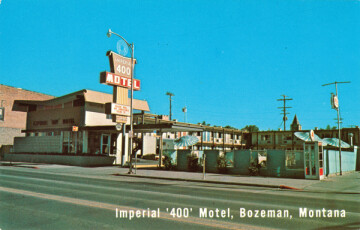Historic District Spotlight:
Main Street Hospitality
Courtney Kramer | Wednesday Dec. 31st, 2014
A handful of new hotels are under construction in downtown Bozeman, three of which directly impact a historic structure. Kenyon Noble, built in 1957 on Mendenhall Street, has been demolished to make way for an Element by Westin. Across Mendenhall Street, a seven story hotel tower will be constructed above the Armory, built in 1941, to create the Etha Hotel. At the same time, the Imperial Inn, constructed in 1963 on West Main Street, has been re-imagined as the Lark Motel. This round of hotel investment follows a cyclical pattern of developing new, modern guest accommodations near Bozeman’s Main Street, which has graciously welcomed guests since the town’s founding.
John and Amanda Guy established the Guy House Hotel in 1868, on the northwest corner of Main and Black (where the Story Block and Schnee’s shoes now stands). The Guys were experienced hoteliers who operated a farm and hotel near Denver from 1855 to 1864, when they followed the gold rush to Virginia City, Montana Territory.
Built of frame construction, the roof of the two-story Guy House ran parallel to Main Street. The gable ends were finished in the Greek Revival style, which was still popular when the Guys left Missouri in 1849, but was falling out of popularity “back in the States.” A two-story portico covered the building’s central entrance, with a sign for the business on the second story balcony. Guests entered a central hallway to find the office to the left, stairs to the right, and a parlor past the stairs to the right. The dining room and kitchen were straight back from the door. Hotel rooms were located on the first and second floor of the L-shaped building. Sanborn Maps denote the presence of a two-story “W.C.,” presumably the toilet facilities, located at the rear of the building along the alley.
The Guy House served as temporary shelter for a number of new community members awaiting construction of their new homes. The hotel also became the center of the town’s social life, especially after construction of Odell and Chapman’s Billiard Room and Hall next door to the west. The two businesses partnered for a ball on New Year’s Eve 1871. The Avant Courier reported that the $5 tickets included an excellent supper in the Guy House’s dining room and music by Prof. Mount’s String and Brass Band.
The Guys sold the hotel to Philip Dodson by 1871, as Guy’s business interests evolved towards developing his land south of Main Street, near what is now Bogert Park. Dodson advertised the Guy House as, “now at the height of a long and successful career,” with cheap prices and good fare. A week’s lodging cost $8.00, with another $4.00 per week for board. A single meal and a single bed both cost 75 cents, though guest may have had to share a bed with another guest. The cook, J. McKinna, was attributed with “a peculiar knack of manipulating a tough piece of beef into a juicy, tender steak.”
The Guy House was renamed the Northern Pacific Hotel after arrival of the railroad in March 1883. Bozeman’s Main Street commercial district is unique for its distance from the railroad tracks, which forced visitors to choose between a boarding house near the railroad tracks or a ten-block trolley ride to find a room on Main Street. The Metropolitan Hotel, LaClede Hotel and a variety of inns and boarding houses were clustered around Main Street by the early 1880’s. The Guy House was demolished in 1900, to make way for construction of the Story Block on Black and Main (now the location of Schnee’s shoes).
Local businessmen began calling for a substantial, first-class hotel by the middle 1880’s, preferably a substantial brick building whose hotel rooms offered all the modern conveniences. Around the same time, boosters decided to promote Bozeman as the state capital location in the election scheduled to occur after statehood in 1889.
Investors commissioned a number of substantial buildings in an effort to make the community more impressive to voters, including the Opera House and City Hall on the southwest corner of east Main Street and Rouse Avenue in 1890. Across the street, a two-story frame residence was demolished to make way for the substantial Hotel Bozeman, for which community members purchased $20,000 in subscriptions to help fund the $100,000 building. Sanborn Maps records the stone foundation in the ground by July 1890, and noted the site to be “Stone foundation for Hotel Bozeman. To be 4 story brick. Composite roof. Fire walls out outsides and front. Being built.”
In late January 1891, the Helena Independent newspaper reported that George Wakefield and John Callaghan won the bid to operate the hotel. They agreed to pay the owners, “a monthly rental of $650 for the building, which has eighty-three furnished bedrooms, a dining room capable of seating two hundred people, a bar room and billiard room.” Wakefield previously operated transportation in Yellowstone Park and Callaghan ran hotels in Miles City and Livingston. 
The Hotel Bozeman hosted a grand opening reception on March 2, 1891. “Fully 1,000 guests were present,” reported the Independent Record. Music filled the halls, and as soon as the immense throng could be accommodated at the tables dancing was commenced to be continued until early morning.” The Independent Record’s article gave a brief insight into Bozeman’s working class by reporting, “The hotel is provided with English porters, colored waiters, French cooks and all the accessories of a first class modern hotel.”
Designed by Fargo, ND, architect George Hancock in the Romanesque style, Hotel Bozeman offered steam radiator heat and a bathroom at the end of each main hallway and eventually included a hydro-powered elevator. Community members expressed pride in the Hotel Bozeman by using its image in advertising associated with the unsuccessful state capitol campaign of 1892. The building is the eastern bookend of the Main Street Historic District.
Bozeman’s Main Street commercial district continued to grow towards the west through the first two decades of the 20th century. By the mid-1920’s, downtown Bozeman offered the Hotel Bozeman, the Hotel Baltimore, the Fechter Hotel and a number of smaller inns and rooming houses. Businessmen began calling for a new hotel to attract visitors and provide additional public event space. The Baxter Hotel opened on the north west corner of Main and Central Avenue (renamed Willson a year later) on March 2, 1929; 38 years to the day since the opening of the Hotel Bozeman. 
The Baxter Hotel offered spacious rooms, each with an attached bath. Guests entered through a grand two-story lobby that lead to a two-story ballroom on the north side of the building. A wrought-iron staircase lead to a mezzanine overlooking the ballroom (a floor was added at mezzanine level in the 1950’s, cutting the ballroom’s height in two). The building was named for local rancher George Baxter, whose substantial investment in the Bozeman Community Hotel Corporation secured financing for the project.
Designed by local architect Fred Willson in the Art Deco style, the Baxter Hotel is the western bookend to the Main Street Historic District. The hotel operated until 1982, when the build was made into residential condominium units.
Visitors increasingly arrived via automobile, despite a major renovation of the Northern Pacific Railway’s Front Street Station in 1924. Tourists bound for Yellowstone National Park arrived via the Yellowstone Trail, which connected Seattle and Chicago through Bozeman. A handful of “tourist-park” style establishments were built. As prototype motels, these accommodations offered a place to park the family automobile in front of the door to a bedroom. Toilet and bathroom facilities were offered in a building at the center of the courtyard. The “Tourist Park” on the 400 block of North Willson Avenue remains intact, and is now residential units. Other “Tourist Parks” were offered on West Main Street, where the Lewis & Clark Motel is now located, and on South 6th Avenue.
Investment in car-oriented “Motels” exploded in the Post World War II years, as raising prosperity and the construction of the Inter-State Highway system brought tourists to Bozeman. By the end of the 1950’s Motel-style accommodations like the Blue Sky Motel and Ranch House Motel were under construction on East Main Street, and the Bozeman Inn, Holiday Inn and Royal 7 welcomed visitors on North 7th Avenue. Motels continued the “Tourist Park” tradition of parking a vehicle directly in front the bedroom door, but offered an en-suite bathroom and, increasingly, television. 
Built in 1963 on West Main Street, the Imperial 400 Inn offered Motel-style accommodations right across the street from the Baxter Hotel. The Imperial was a California-based chain, with franchises in Montana, Idaho, Nevada, Arizona and California. The Modern architecture included a butterfly roof over the office suite, exterior staircases and a pool on the property’s northwest corner.
The Imperial is currently under major re-construction, as the creatively re-imagined Lark Motel. The Baxter Hotel and Hotel Bozeman remain cornerstones of Bozeman’s Main Street hospitality, though they no longer offer overnight accommodations. The 2010’s round of reinvestment in downtown hotels caters to heritage tourists; visitors who want an authentic experience of Bozeman’s joie de vivre, a large part of which is derived from our continued reinvestment in historic buildings.
| Tweet |
